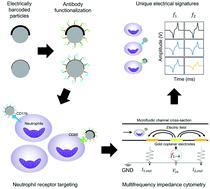Our official English website, www.x-mol.net, welcomes your feedback! (Note: you will need to create a separate account there.)
Antibody-functionalized aluminum oxide-coated particles targeting neutrophil receptors in a multifrequency microfluidic impedance cytometer
Lab on a Chip ( IF 6.1 ) Pub Date : 2022-07-05 , DOI: 10.1039/d2lc00563h Brandon K Ashley 1 , Jianye Sui 2 , Mehdi Javanmard 1, 2 , Umer Hassan 1, 2, 3
Lab on a Chip ( IF 6.1 ) Pub Date : 2022-07-05 , DOI: 10.1039/d2lc00563h Brandon K Ashley 1 , Jianye Sui 2 , Mehdi Javanmard 1, 2 , Umer Hassan 1, 2, 3
Affiliation

|
Personalized diagnostics of infectious diseases require monitoring disease progression due to their ever-changing physiological conditions and the multi-faceted organ system mechanisms involved in disease pathogenesis. In such instances, the recommended clinical strategies involve multiplexing data collection from critical biomarkers related to a patient's conditions along with longitudinal frequent patient monitoring. Numerous detection technologies exist both in research and commercial settings to monitor these conditions, however, they fail to provide biomarker multiplexing ability with design and data processing simplicity. For a recently conceived multiplexing biomarker modality, this work demonstrates the use of electrically sensitive microparticles targeting and identifying membrane receptors on leukocytes using a single detection source, with a high potential for multiplexing greater than any existing impedance-based single-detection scheme. Here, polystyrene microparticles are coated with varying thicknesses of metal oxides, which generate quantifiable impedance shifts when exposed to multifrequency electric fields depending on the metal oxide thickness. Using multifrequency impedance cytometry, these particles can be measured and differentiated rapidly across one coplanar electrode scheme. After surface-functionalizing particles with antibodies targeting CD11b and CD66b receptors, the particles are combined with isolated neutrophils to measure receptor expression. A combination of data analysis techniques including multivariate analysis, supervised machine learning, and unsupervised machine learning was able to accurately differentiate samples with up to 91% accuracy. This proof-of-concept study demonstrates the potential for these oxide-coated particles for enumerating specific leukocytes enabling multiplexing. Further, additional coating thicknesses or different metal oxide materials can enable a compendium of multiplexing targeting resource to be used to develop a high-multiplexing sensor for targeting membrane receptor expression.
中文翻译:

多频微流体阻抗细胞仪中靶向中性粒细胞受体的抗体功能化氧化铝涂层颗粒
由于传染病的生理条件不断变化以及疾病发病机制涉及多方面的器官系统机制,传染病的个性化诊断需要监测疾病进展。在这种情况下,推荐的临床策略包括从与患者状况相关的关键生物标志物中收集多路数据,并进行纵向频繁的患者监测。研究和商业环境中存在许多检测技术来监测这些条件,但是,它们无法提供生物标志物多重分析能力以及设计和数据处理的简单性。对于最近构思的多重生物标志物模式,这项工作展示了使用电敏微粒使用单一检测源靶向和识别白细胞上的膜受体,其多重化的潜力比任何现有的基于阻抗的单一检测方案更大。在这里,聚苯乙烯微粒涂有不同厚度的金属氧化物,当暴露于多频电场时,金属氧化物会根据金属氧化物的厚度产生可量化的阻抗变化。使用多频阻抗细胞术,可以通过一种共面电极方案快速测量和区分这些颗粒。用针对 CD11b 和 CD66b 受体的抗体对颗粒进行表面功能化后,将颗粒与分离的中性粒细胞结合以测量受体表达。多变量分析、监督机器学习和无监督机器学习等数据分析技术的结合能够准确地区分样本,准确率高达 91%。这项概念验证研究证明了这些氧化物涂层颗粒在计数特定白细胞方面的潜力,从而实现多重分析。此外,额外的涂层厚度或不同的金属氧化物材料可以使多重靶向资源的概要能够用于开发用于靶向膜受体表达的高多重传感器。
更新日期:2022-07-05
中文翻译:

多频微流体阻抗细胞仪中靶向中性粒细胞受体的抗体功能化氧化铝涂层颗粒
由于传染病的生理条件不断变化以及疾病发病机制涉及多方面的器官系统机制,传染病的个性化诊断需要监测疾病进展。在这种情况下,推荐的临床策略包括从与患者状况相关的关键生物标志物中收集多路数据,并进行纵向频繁的患者监测。研究和商业环境中存在许多检测技术来监测这些条件,但是,它们无法提供生物标志物多重分析能力以及设计和数据处理的简单性。对于最近构思的多重生物标志物模式,这项工作展示了使用电敏微粒使用单一检测源靶向和识别白细胞上的膜受体,其多重化的潜力比任何现有的基于阻抗的单一检测方案更大。在这里,聚苯乙烯微粒涂有不同厚度的金属氧化物,当暴露于多频电场时,金属氧化物会根据金属氧化物的厚度产生可量化的阻抗变化。使用多频阻抗细胞术,可以通过一种共面电极方案快速测量和区分这些颗粒。用针对 CD11b 和 CD66b 受体的抗体对颗粒进行表面功能化后,将颗粒与分离的中性粒细胞结合以测量受体表达。多变量分析、监督机器学习和无监督机器学习等数据分析技术的结合能够准确地区分样本,准确率高达 91%。这项概念验证研究证明了这些氧化物涂层颗粒在计数特定白细胞方面的潜力,从而实现多重分析。此外,额外的涂层厚度或不同的金属氧化物材料可以使多重靶向资源的概要能够用于开发用于靶向膜受体表达的高多重传感器。



























 京公网安备 11010802027423号
京公网安备 11010802027423号